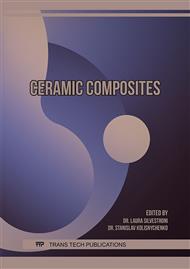p.115
p.121
p.131
p.140
p.148
p.153
p.161
p.167
p.171
Powder Injection Molding of Oxide Ceramic CMC
Abstract:
Ceramic Matrix Composites (CMC) offer improved mechanical properties, especially higher toughness, preferably at elevated temperatures. Fields of application are, for example, highly hot stressed components of aero engines.Processing of Ceramic Matrix Composites by powder injection molding offers attractive economic benefits, however, it represents a considerable challenge. Development of a process chain for the ceramic injection molding of Al2O3 short fiber CMC had started by feedstock preparation and characterization. Fiber content varied between 10 to 50 vol.% whereas for binder a well-examined system from KIT was chosen. The fiber content showed a minor effect on the rheological properties but fiber orientation depended strongly on the apparent shear profile. The sintering behavior was affected as well, i.e. higher densities were achieved.
Info:
Periodical:
Pages:
148-152
Citation:
Online since:
June 2019
Price:
Сopyright:
© 2019 Trans Tech Publications Ltd. All Rights Reserved
Share:
Citation:



